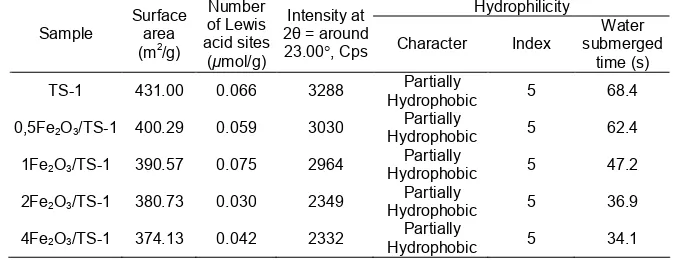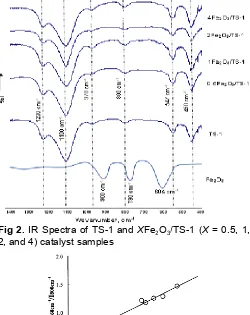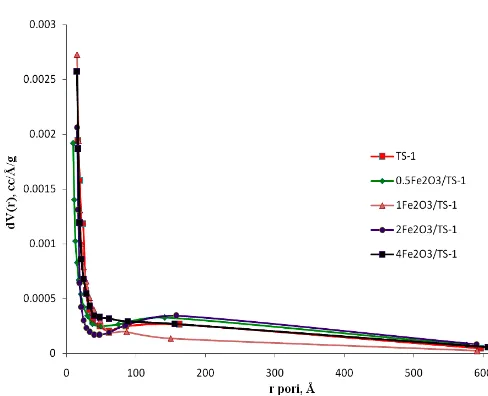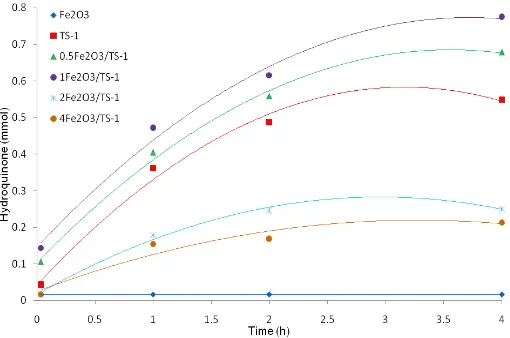CATALYTIC PERFORMANCES OF Fe
2O
3/TS-1 CATALYST IN PHENOL
HYDROXYLATION REACTION
Didik Prasetyoko
1,*, Cholifah Endah Royani
1, Hamzah Fansuri
1, Zainab Ramli
2, and Hadi Nur
21
Laboratory of Inorganic Chemistry, Department of Chemistry, Faculty of Mathematic and Sciences, Institut Teknologi Sepuluh Nopember (ITS), Surabaya, Indonesia
2
Ibnu Sina Institute for Fundamental Science Studies, University Teknologi Malaysia (UTM), Johor Bahru, Malaysia
Received April 22, 2010; Accepted July 6, 2010
ABSTRACT
Hydroxylation reaction of phenol into diphenol, such as hydroquinone and catechol, has a great role in many industrial applications. Phenol hydroxylation reaction can be carried out using Titanium Silicalite-1 (TS-1) as catalyst and H2O2as an oxidant. TS-1 catalyst shows high activity and selectivity for phenol hydroxylation reaction. However, its hydrophobic sites lead to slow H2O2adsorption toward the active site of TS-1. Consequently, the reaction rate of phenol hydroxylation reaction is tends to be low. Addition of metal oxide Fe2O3 enhanced hydrophilicity of TS-1 catalyst. Liquid phase catalytic phenol hydroxylation using hydrogen peroxide as oxidant was carried out over iron (III) oxide-modified TS-1 catalyst (Fe2O3/TS-1), that were prepared by impregnation method using iron (III) nitrate as precursor and characterized by X-ray diffraction, infrared spectroscopy, nitrogen adsorption, pyridine adsorption, and hydrophilicity techniques. Catalysts 1Fe2O3/TS-1 showed maximum catalytic activity of hydroquinone product. In this research, the increase of hydroquinone formation rate is due to the higher hydrophilicity of Fe2O3/TS-1 catalysts compare to the parent catalyst, TS-1.
Keywords:Fe2O3/TS-1, hydrophilic site, phenol hydroxylation
INTRODUCTION
Widespread contamination of water by phenol and phenolic compounds has been recognized as an issue of growing importance in recent years. Phenol and phenolic compounds are a group of organic pollutants that often appear in wastewaters from many heavy chemical, petrochemical, and oil refining industries. Phenol is carcinogenic and is a considerable health concern, even at low concentration. Because of their toxicity and poor biodegradability, phenolic wastewaters must be specially treated before disposing off.
Various treatment techniques have been applied to remove or eliminate phenolic compounds from wastewaters, including chemical oxidation [1], solvent extraction [2], membrane techniques [3], adsorption [4], photo degradation [5], coagulation flocculation [6], and biological process [7] and so on. Ozone, oxygen, hydrogen peroxide or a combination of them are frequently used as oxidant. However, such technologies usually involve complicated procedures and are not economically viable. The catalytic oxidation process is a well-established technique to decompose toxic and/or non-biodegradable organic compounds in wastewaters [8], which is able to oxidize organic pollutants into products that can be very useful for humankind.
Earlier studies reported in the literature deal mainly with hydroxylation of phenol, whereas the oxidation of
peroxide as oxidant [10]. TS-1 has been commercialize in hydroxylation reaction of phenol with high hydroquinone selectivity (hydroquinone/catechol ratio = 1) and high H2O2 efficiency [11]. Hydroxylation reaction of phenol with TS-1 catalyst shows high activity and selectivity, become clean reaction with low H2O2 non-productive decomposition, and high catalyst stability [12].
TS-1 can lessen tar product and side products which have potential as pollutant. Reaction mechanism of phenol hydroxylation is as follows: (1) TS-1 will decompose H2O2(oxidation agent) which has hydrophilic character to form titanium-peroxo radical (initiation step), then (2) propagation step in solution [13]. This mechanism can be explained via titanium-peroxo complex formation mechanism as intermediate from reaction between H2O2 and TS-1 catalyst [10, 14-17]. The rate of the formation of titanium-peroxo depended on the rate of H2O2 reach to active site in TS-1. H2O2 is hydrophilic, that is quite different from hydrophobic character of TS-1 [18], consequently the reaction rate of phenol hydroxylation reaction is tends to be low [15]. One of the way to increase phenol hydroxylation reaction rate with TS-1 catalyst is by making TS-1 become more hydrophilic character, and the reaction rate of phenol hydroxylation will be much faster and shows increasing of catalytic activity and selectivity higher than TS-1. Hydrophilic improvement of catalyst can be carried out by addition of metal oxide which leads to increasing of acidity properties. The existence of metal oxide in TS-1 catalyst can gives acid site which capable to increase catalyst hydrophilicity, so that reactant adsorption in catalyst becomes faster [19-20]. Heterogeneous catalytic process in phenol hydroxylation reaction can be carried out with pure metals oxide or supported oxide such as MoO3, CuO/SiO2, Fe2O3, Fe2O3/Al2O3, Co3O4, V2O5 and colloid particle of TiO2. However, this metal oxides show very low catalytic activity and selectivity [21].
In previous research by Indrayani [22], synthesis and catalytic activity were carried out with low-loading of MoO3/TS-1 catalyst in phenol hydroxylation reaction. MoO3/TS-1 catalysts have showed improvement of hydrophilicity along with the increasing of MoO3 content in MoO3/TS-1 catalyst. The improvement of hydrophilic character of MoO3/TS-1 catalyst is also accompanied with the improvement of its catalytic activity in phenol hydroxylation reaction. In this paper, TS-1 catalyst was modified by addition of metal oxide Fe2O3on the surface of TS-1 catalyst. The existence of Fe2O3 on the TS-1 surface is expected to make this new catalyst (Fe2O3/TS-1) has higher hydrophilic character compared to TS-1, and the rate of phenol hydroxylation reaction becomes faster than TS-1.
EXPERIMENTAL SECTION
Materials
Materials that have been used in this study are as follows, i.e. tetraethyl orthosilicates, TEOS (Merck, 98%), tetraethyl orthotitanate, TEOT (Merck, 95%), isopropyl alcohol, tetrapropylammonium hydroxide, TPAOH (Merck, 20% TPAOH in water), distilled water, and iron (II) nitrate Fe(NO3)3. 9H2O.
Instrumentation
The solid structure of catalyst TS-1 and Fe2O3/TS-1 was determined using X-ray diffraction (XRD) and infrared spectroscopy technique, X-ray powder diffraction (XRD) patterns were collected using the Ni-filtered Cu-Kα radiation (λ = 1.5406 Å) as the diffracted monochromatic beam at 40 kV and 40 mA. The pattern was scanned in the 2 ranges from 5o to 50o at a step size 0.010o and step time 1s. Infrared spectra of the catalyst TS-1 and Fe2O3/TS-1 samples were collected on a Shimadzu Fourier Transform Infrared, with scans 20 s by KBr pellet method. The framework spectra were recorded in the region of 1400–400 cm-1. The acidity of samples were determined by infrared spectroscopy technique using pyridine as probe molecule. The wafer of the sample (10–12 mg) was locked in the cell equipped and evacuated at 400 °C under vacuum condition for 4 h, continued by adsorption of pyridine at room temperature. After evacuation at 150 °C for 3 h, infrared spectra of the sample were recorded at room temperature in the region of 1400–1700 cm-1 using Shimadzu Fourier Transform Infrared (FTIR). The catalysts hydrophilicity is analyzed by catalyst sample powder dispersion method at water phase and organic phase mixture (water and xylene). A mixture of xylene and water, which do not mix with each other, is employed to test the hydrophobic characteristics of the samples. Xylene and water of the same volume are added into a test tube to form a stable phase interface. TS-1 and Fe2O3/TS-1 catalyst samples are, respectively, dispersed in the xylene–water system and stirred. After the mixture has stabilized, the hydrophobic characteristics can be qualitatively evaluated by inspecting the state of the floating/sinking of samples at the interface [24].
Procedure
Catalysts Preparation
containing 0.3145 mol of silicon was placed into a Teflon beaker and vigorously stirred, tetraethyl orthotitanate, TEOT (Merck, 95%) containing 0.0032 mol of titanium in isopropyl alcohol was carefully added dropwise into this TEOS. The beaker was covered with parafilm to avoid hydrolysis. The temperature of the mixture was raised to 35 °C and the reactants were mixed homogeneously for pf an h to obtain depolymerisation of the titanate oligomers that may be present in TEOT. Then the mixture was cooled to about 0 °C. The solution of tetrapropylammonium hydroxide, TPAOH (Merck, 20% TPAOH in water), which was used as template, was also cooled to 0 °C. After a few minutes, TPAOH containing 0.1287 mol of TPAOH was added drop-wise slowly into the mixture of TEOS and TEOT. At first, one should wait a few minutes after addition of a few drops of TPAOH solution before more TPAOH solution is added, to avoid precipitation. Stirring and cooling were continued during this process. After the addition of about 10 mL the addition rate of TPAOH solution was increased. When the addition of TPAOH was completed, the mixture was heated in the temperature range of 80–90 °C for about 4 h in order for the hydrolysis of TEOS and TEOT to take place. Distilled water was added to increase the volume of the mixture to about 127 mL, after which a clear gel was obtained. The gel was transferred into a 150 mL autoclave and heated at 175 °C under static condition. The material was recovered after 4 days of hydrothermal crystallization by centrifugation and washing with excess distilled water. A white powder was obtained after drying in air at 100 °C overnight [23].
The Fe2O3/TS-1 catalysts were prepared by incipient wetness impregnation of TS-1 with an aqueous solution containing sufficient amount of iron (II) nitrate Fe(NO3)3. 9H2O, to yield materials with loading in the ranges of 0.5–4 wt% of Fe2O3 in the calcined state. The suspension was heated at 80 °C for 3 h under stirring condition, followed by evaporation of water, drying at 100 °C for 7 h, and calcination at 500 °C for 3 h. The samples were denoted by their weight percentage of Fe2O3on TS-1.
Catalytic Performance
The catalyst performance was tested in the hydroxylation of phenol using aqueous H2O2 (30%) as oxidant. The reaction mixture containing phenol, H2O2, and solvent (methanol and acetone) was put together in a round bottom flask equipped with a condenser. The catalyst was then added to the solution. The reaction was carried out in an oil bath under stirring at 70 °C. The products of the reaction were analyzed by an Agilent gas chromatograph using an HP 5 non polar column with FID detector.
RESULT AND DISCUSSION
Characterization
TS-1 and Fe2O3/TS-1 catalysts were characterized by X-ray diffraction technique. The XRD patterns of the Fe2O3, TS-1 and Fe2O3/TS-1 samples with various iron loading are shown in Fig. 1. Characteristic diffraction lines of TS-1 is observed at 2= 7.94; 8; 23.08; 23.62; 23.88; 23.92°. The peak at 2 around 24° is observed for the orthorombic symmetry, which is symmetry of TS-1. This Phenomenon indicates that titanium atom is already exist
Fig 1.X-ray Diffraction Pattern of the Fe2O3,TS-1, and XFe2O3/TS-1 (X= 0.5, 1, 2, and 4) catalyst samples
Table 1.Physical and chemical properties of the TS-1, andXFe2O3/TS-1 (X= 0.5, 1, 2, and 4) catalyst samples Hydrophilicity
Sample
Surface area (m2/g)
Number of Lewis acid sites
(µmol/g)
Intensity at 2θ = around
23.00°, Cps Character Index
Water submerged
time (s)
TS-1 431.00 0.066 3288 Partially
Hydrophobic 5 68.4
0,5Fe2O3/TS-1 400.29 0.059 3030
Partially
Hydrophobic 5 62.4
1Fe2O3/TS-1 390.57 0.075 2964 HydrophobicPartially 5 47.2 2Fe2O3/TS-1 380.73 0.030 2349
Partially
Hydrophobic 5 36.9
4Fe2O3/TS-1 374.13 0.042 2332 Partially
Fig 2. IR Spectra of TS-1 andXFe2O3/TS-1 (X= 0.5, 1, 2, and 4) catalyst samples
Fig. 3. Ratio intensity of I970/I800 with TiO2 content (mol %) with titanium content ( = Ti4+) in zeolite framework [26]
Fig 4.Infrared spectra of the TS-1 and XFe2O3/TS-1 (X = 0.5, 1, 2, and 4) catalyst samples after evacuation at 400oC in vacuum followed by pyridine adsorption at room temperature and desorption at 150 °C for 3 h
in the framework structure of TS-1 [25]. No diffraction line assigned for crystalline phase of the iron (II) oxide is present in the XRD pattern of Fe2O3/TS-1 catalysts; and generally, the MFI structure of TS-1 still retained after dispersion of Fe2O3to TS-1. This finding indicated that the MFI structure of TS-1 is not collapsed after impregnation of Fe2O3.
However, the peak intensities of the Fe2O3/TS-1 samples decrease with the increase of Fe2O3 loading, due to the increase concentration of the Fe2O3 on the surface of the TS-1. It is suggested that Fe2O3could be located on the surface of TS-1 or covering the surface of TS-1. The crystallinity of Fe2O3/TS-1 catalysts (based on the highest diffraction line of TS-1) are summarized in Table 1.
The infrared spectra of the samples (Fig. 2) showed absorption band at around 970 cm-1 and 800 cm-1, which absorption band at around 970 cm-1is characteristic of TS-1 in vibration mode of stretching Si-O from unit [SiSi-O4], which tied at atom Ti
4+ with tetrahedral coordination in TS-1 framework. Absorption band at this wavenumber is an evidence that titanium atom has already stayed inside the structure of catalyst framework [26]. Absorption band at around 800 cm-1is symmetrical vibration mode of SiO4or AlO4tetrahedral. No additional band after impregnation of Fe2O3into TS-1 can be observed. This finding shows that impregnation of Fe2O3 has not affected the MFI structure of TS-1 significantly. Relative intensity at I970/I800 shows the titanium content in zeolite framework, and it described by the ratio between 970 cm-1and 800 cm-1line area. Fig. 3 shows ratio intensity ofI970/I800with TiO2 content (mol %) in zeolite framework. I970/I800 value of TS-1 is found 0.97, and it resulted in 1.70 (mol)% of titanium content of TS-1.
Fig 5. N2 adsorption–desorption isotherms of the calcined TS-1 and XFe2O3/TS-1 (X = 0.5, 1, 2, and 4) catalyst samples
Fig 6. Pore size distribution of the calcined TS-1 and XFe2O3/TS-1 (X= 0.5, 1, 2, and 4) catalyst samples
solid itself. According to Nur et al. [29] and Prasetyoko et al. [30], the existence of acid sites can enhanced hydrophilicity of TS-1 catalyst, which can be carried out by addition of metal oxide to catalysts. Therefore, reactant adsorption to catalyst become much faster.
According to Table 1, 1Fe2O3/TS-1 catalyst tends to have higher Lewis acid sites amount than TS-1 and other XFe2O3/TS-1 catalyst (0.028 mol/g). This finding has also affirmed by the result of catalysts hydrophilicity test, which will be discussed later in this paper. The random amount of Lewis acid sites indicates that there was no chemical bonding formed between Fe2O3 and TS-1, and possibly the interaction between Fe2O3 and TS-1 was unfavourable dispersion phenomenon.
TS-1 and Fe2O3/TS-1 catalysts specific surface areas were measured based on the Brunauer-Emmett-Teller (BET) isotherm using nitrogen adsorption. Fig. 5 illustrates the N2 adsorption/desorption isotherm of TS-1 and Fe2O3/TS-1 catalyst samples. The isotherm of TS-1 and Fe2O3/TS-1 catalyst samples exhibits a sharp transition in adsorption branch followed by a linear section with a very gentle slope, which indicates its microporous structure. This result was confirmed with The Barrett–Joyner–Halenda (BJH) analysis of the desorption isotherms in Fig. 6. Single significant peak is found in the BJH pore size distribution plots of XFe2O3/TS-1 (X = 0.5, 1, 2, and 4) catalyst samples. As shown in Fig. 6, the pores are distributed in ranges below 2 nm (20 Å), which is the ranges characteristic for microporous material. The hysteresis loop at high P/P0 (0.9–1.0) can be attributed to the interparticle spaces formed by the nanometer sized particles [31]. Surface area progressively decreased with increasing Fe2O3 concentration. The results of catalyst samples surface
area are presented in Table 1. Similar findings have been reported by Li et al. [25], which reported that specific surface area of TS-1 catalyst is approximately 310-463 m2/g.
The results of hydrophobic tests are shown in Table 1. TS-1 and Fe2O3/TS-1 catalyst samples seem to show similar behavior during the hydrophilicity test. It indicates that the addition of metal oxide Fe2O3on TS-1 surface didn’t give too much effect in TS-1 catalyst properties, which is partially hydrophobic. Nevertheless, the addition of metal oxide Fe2O3on TS-1 surface makes Fe2O3/TS-1 catalysts has higher hydrophilicity than TS-1 catalyst. Table 1 show that the higher Fe2O3 loading in TS-1 catalyst resulted in the faster sinks of Fe2O3/TS-1 catalysts into water. It suggested that the increasing of the catalyst hydrophilicity character is accompanied with the increasing of metal oxide Fe2O3 content at TS-1 catalyst. However, 1Fe2O3/TS-1 catalyst tends to show significant increasing of hydrophilicity character. Which shown in the higher speed of samples to sink in the water.
Catalytic Performance
Fig 7. Yield of hydroquinone from phenol hydroxylation using H2O2 as oxidant and methanol as solvent at 70 °C catalyzed by Fe2O3, TS-1 andXFe2O3/TS-1 (X = 0.5, 1, 2, and 4) catalyst samples
Fe2O3 is not active in the hydroxylation of phenol. All samples except Fe2O3 show activity towards the hydroxylation of phenol. 1Fe2O3/TS-1 shows the highest rate of formation of hydroquinone up to 4 h reaction time, follows by 0.5Fe2O3/TS-1. The high rate of formation of hydroquinone observed in the reaction mixture catalyzed by samples Fe2O3/TS-1 may due to the presence of Fe2O3 in the catalysts. It can be seen in Fig. 7 that the rate of formation of hydroquinone increased very rapidly at the initial stage, and then further increased gradually with the reaction time up to 4 h. The highest hydroquinone formed in phenol hydroxylation is obtained by using 1Fe2O3/TS-1 as catalyst compare to other catalysts up to 0.774 mmol in 4 h reaction. The high rate of the formation of hydroquinone observed in the initials stage of reaction time on Fe2O3/TS-1 catalysts can be explained in term of the hydrophilicity of the catalysts. Generally, in the catalytic reaction by heterogeneous catalysts, the first step of the reaction involve adsorption of the substrate on the surface of the catalysts to form intermediate, followed by reaction in the catalyst, and finally desorption of the product from the catalyst. In this reaction, phenol is a non-polar molecule, while H2O2is a polar molecule. Therefore, phenol will be adsorbed immediately at the catalyst with high hydrophobicity. Sample TS-1 has higher hydrophobic properties as compare to samples Fe2O3/TS-1. Consequently, when catalyst TS-1 is added into the solution of phenol and H2O2, the adsorption of phenol on the TS-1 is faster than that of H2O2. Meanwhile, it is known that in the hydroxylation of phenol, the active site is peroxo-titanium complex which form by interaction of titanium species of TS-1 with hydrogen peroxide. Therefore, it is expected that the faster interaction of H2O2with titanium in the TS-1 result the faster formation of peroxo-titanium species.
As a result, the formation of hydroquinone was found to be increased. Based on these finding, it is concluded that the high rate of the formation of hydroquinone observed on Fe2O3/TS-1 catalysts may due to the higher hydrophilicity of these catalysts as compare with sample TS-1.
Meanwhile, 2Fe2O3/TS-1 and 4Fe2O3/TS-1 shows the rate decreasing of the formation of hydroquinone. It suggested that the pore opening of TS-1 is blocked by iron (II) oxide at the high amount of Fe2O3loading. This explanation is supported by the finding of the rate decreasing of formation of hydroquinon on 2Fe2O3 /TS-1 and 4Fe2O3/TS-1 samples compare to TS-1 sample (Fig. 7). This explanation is also affirmed by the surface area of 2Fe2O3/TS-1 and 4Fe2O3/TS-1 catalysts, whereas the surface area of 2Fe2O3/TS-1 and 4Fe2O3/TS-1 catalysts is decreasing along with the increasing of Fe2O3 content in TS-1. The yield of hydroquinone decreased as Fe2O3 loading increased higher that 1 wt% in all reaction time. This finding suggests the capability of substrate to access the peroxo-titanium active sites inside the pore of TS-1 is easier for lower amount of Fe2O3 loading. Similar findings have been reported by Prasetyoko et al. [30], which reported that the yield of 1,2-epoxyoctane from 1-octene epoxidation decreased as WO3loading in TS-1 increased higher that 7 wt% due to the blocking pores of TS-1 by tungsten oxide WO3 at the high amount of WO3loading in TS-1.
CONCLUSION
Catalyst TS-1 and Fe2O3/TS-1 show the catalytic activity towards the hydroxylation of phenol. 1Fe2O3/TS-1 catalyst shows the highest rate of formation of hydroquinone due to the presence of Fe2O3in the catalysts in term of the hydrophilicity of the catalysts. 4Fe2O3/TS-1 catalyst shows the lowest rate decreasing of the formation of hydroquinone due to the blocking pores of TS-1 by Fe2O3at the high amount of Fe2O3loading in TS-1.
ACKNOWLEDGEMENT
We gratefully acknowledge funding from the Directorate General of Higher Education, Indonesia, under Hibah Kompetensi No. 0300/I2.7/PM/2010 and TWAS Research Grant No. 08-137 RG/CHE/AS.
REFERENCES
1. Liou, R.M., Chen, S.H., and Hung, M.Y., 2005, Chemosphere,59, 117–125.
3. Wojciech, K., Andrzej, W., and Wlodzimierz, R., 2004,Desalination, 163, 287–296.
4. Ahmaruzzaman, M., and Sharma, D.K., 2005, J. Colloid Interface Sci., 287, 14–24.
5. Will, I.B., Moraes, J.E., and Teixeira, A.C., 2004, Sep. Purif. Technol., 34, 51–57.
6. Tomaszewska, M., Mozia, S., and Morawski, W., 2004,Desalination, 162, 79–87.
7. Tziotzios, G., Teliou, M., and Kaltsouni, V., 2005, Biochem. Eng. J., 26, 65–71.
8. Luck, F., 1999,Catal. Today, 53, 81–91.
9. Tang, H., Ren, Y., Yue, B., Yan, S., and He, H., 2006,J. Mol. Catal. A: Chem., 260, 121–127. 10. Liu, H., Lu, G., Guo, Y.L., Guo, Y., and Wang, J.,
2006,Chem. Eng. J.,116, 179–186.
11. Choi, J., Yoon, S., Jang, S., and Ahn, W., 2006, Catal. Today, 111, 280–287.
12. Liu, X., Wang, X., Guo, X., and Li, G., 2004, Catal. Today, 93–95, 505–509.
13. Kurian, M., and Sugunan, S., 2006, Chem. Eng. J., 115, 39–146.
14. Vayssilov, G.N., and van Santen, R.A., 1998, J. Catal., 175, 170–174.
15. Sun, J., Meng, X., Shi, Y., Wang, R., Feng, S., Jiang, D., Xu, R., and Xiao, F.S., 2000, J. Catal., 193, 199-206.
16. Wilkenhöner, U., Langhendries, G., Baron, G.V., Gammon, D.W., Jacobs, P.A., and van Steen, E., 2001,J. Catal., 203, 201–212.
17. Bonino, F., Damin, A., Ricchiardi, G., Ricci, M., Spano, G., D’Aloisio, R., Zecchina, A., Lamberti, C., Prestipino, C., and Bordiga, S., 2004, J. Phys. Chem. B, 108, 3573–3583.
18. Armaroli, T., Bevilacqua, M., Trombetta, M., Milella, F., Alejandre, A.G., Ramirez, J., Notari, B., Willey, R.J., and Busca, G., 2001, Appl. Catal., A, 216, 59–71.
19. Nur, H., Prasetyoko, D., Ramli, Z., and Endud, S., 2004,Catal. Commun., 5, 725–728.
20. Prasetyoko, D., Ramli, Z., Endud, S., and Nur, H., 2007,React. Kinet. Catal. Lett., 86, 83–89.
21. Ray, S., Mapolie, S.F., and Darkwa, J., 2007, J. Mol. Catal. A: Chem., 267, 143–148.
22. Indrayani, S., 2008, Thesis, Chemistry Department, ITS, Surabaya, Indonesia.
23. Taramasso, M., Perego, G., and Notari, B., 1983, U.S. Patents No. 4.410.501.
24. Wang, Z., Wang, T., Wang, Z., and Jin, Y., 2004,J. Powder Technol., 139, 148–155.
25. Li, Y.G., Lee, Y.M., and Porter, J.F., 2002, The Synthesis and Caracterization of Titanium Silicalite-1, Kluwer Academic Publishers, 0022– 2461.
26. Gao, H., Lu, W., and Chen, Q., 2000, Microporous Mesoporous Mater., 34, 307–315.
27. Kung, H.H., 1989,Transition Metal Oxides: Surface Chemistry and Catalysis, Stud. Surf. Sci. Catal., Elsevier, New York.
28. Emeis, C.A., 1993,J. Catal., 141, 347–354.
29. Nur, H., Prasetyoko, D., Ramli, Z., and Endud, S., 2004,Catal. Commun., 5, 725–728.
30.Prasetyoko, D., Fansuri, H., Ramli, Z., Endud, S., and Nur, H., 2009,Catal. Lett., 128, 177.



